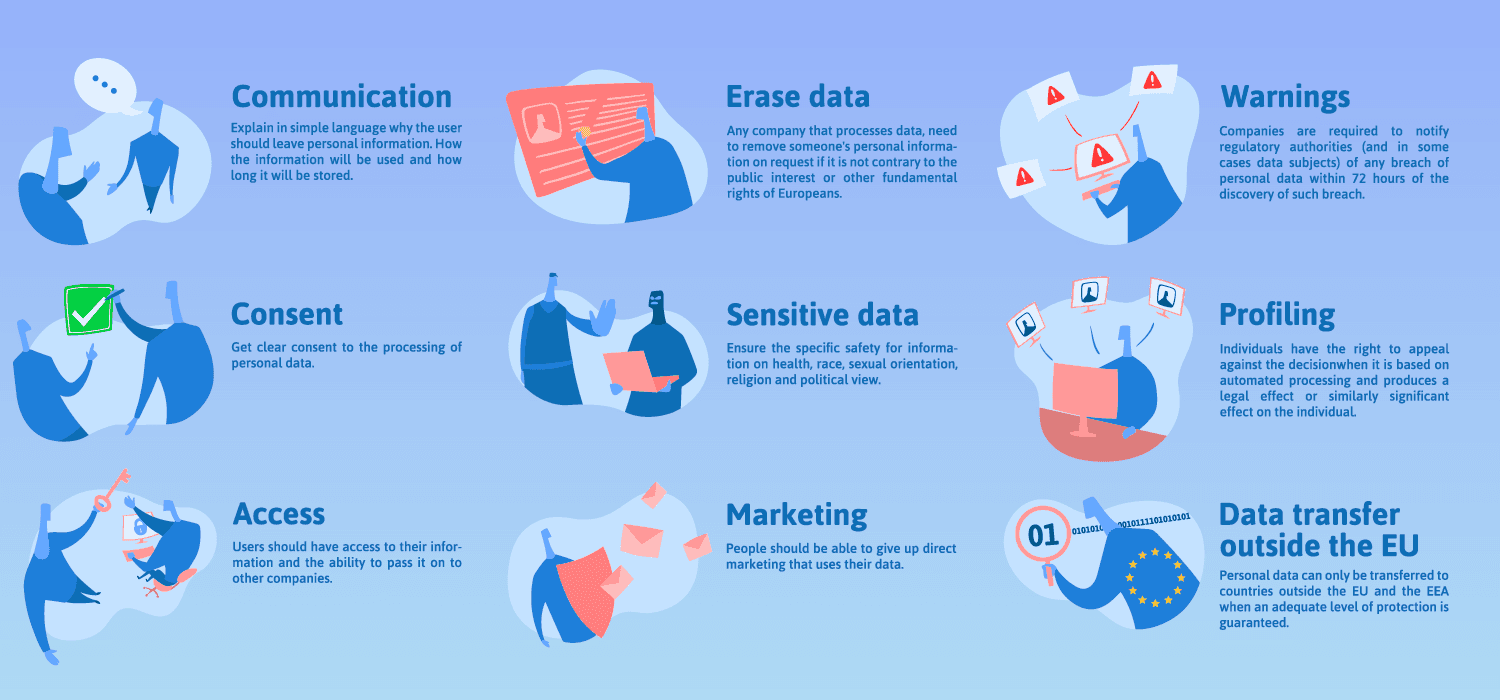The era of big data provides a variety of advantages in every sector and among organizations of all sizes. Never before have advertisers enjoyed such accurate insights into what, exactly, entices customers — and what convinces them to take action.
Despite these benefits, many business owners struggle to balance the need for consumer information against concerns about their customers’ privacy. These competing demands add numerous complications to digital marketing, which is already complex due to its staggering pace of change.
In a competitive economy, small businesses need to make the most of every advantage available — but they also have to establish a sense of trust with core consumers. Strike this delicate balance, and businesses can expect not only repeat business but an impressive level of customer loyalty.
Previously, it was difficult for even well-meaning businesses to deliver on promises of transparency and protection. Now, however, as updated regulations drive innovations among big tech companies, new tools are available for empowering customers to make their own decisions.
Options such as Consent Mode promise to deliver the exact level of privacy internet users desire while still allowing small businesses to take advantage of detailed insights through Google Analytics and Google Ads. Many advertisers remain completely unaware of this option, but it’s about to shake up the concept and execution of digital consent.
What Is Consent Mode? How Does it Work??

In an effort to address issues surrounding digital privacy, Google has introduced a tag management solution known as Consent Mode. This feature mainly aims to provide alternative options for internet users who desire a greater degree of control over their online experience
At its core, Consent Mode involves two main tags: ad_storage and analytics_storage. These serve as filters for managing cookie behavior. Ad_storage takes care of cookie behavior, while analytics_storage focuses on analytic cookie usage.
When these tags are properly set, cookie support parameters can be provided according to visitor activity. If users agree to cookie consent banners, the ad storage tag makes it possible for ad cookies to proceed. If, however, cookie behavior is declined, cookie-based features will not be viewed by the visitor in question. The analytics storage tag acts similarly, granting each user a significant degree of oversight.
Campaigns that run on Google Ads under Consent Mode can continue to report conversions while still respecting each user’s choices regarding cookies. This ability to retain conversion rates is important, as it means that advertisers can still easily determine which campaigns are responsible for marketing successes or failures. This, in turn, will allow for more effective campaign bidding.
The inherent flexibility of Consent Mode means that users can deny some permissions while granting others. For example, users could potentially disable ads cookies while still offering consent for analytics cookies. Regardless of the preferred approach, Google Tag Manager product manager Scott Herman believes that the flexibility of Consent Mode will enable advertisers to “[measure] conversions at a more aggregate level.”
Why Did Google Add Consent Mode?

Although it’s been in development for years, Google’s Consent Mode is believed to primarily be a response to recent internet privacy regulations in Europe. The General Data Protection Regulation (GDPR), in particular, has proven influential in its calls for greater transparency regarding how consumer data is collected and used.
Like many top tech companies, Google supports the IAB Europe Transparency and Consent Framework (TCF). As the sole GDPR consent solution built by industry experts in response to the latest regulations, the TCF aims to help technology vendors, publishers, and other parties affected by Europe’s regulations meet today’s stringent privacy and consent requirements.
While many businesses have opted to use the TCF to handle questions of user consent, this is not true across the board. In an effort to deliver better consent options to businesses not utilizing TCF, Google now offers a dedicated Consent Mode that will provide a similar emphasis on users’ preferences. Despite this clear focus on improving consent options for users, this solution still enables advertisers to measure conversions and get an accurate sense of the return on investment for any given campaign.
Prior to its release, Google’s consent options spent over a year in beta. This detail-oriented approach has allowed experts at Google Analytics to determine exactly how changes in cookie behavior will impact both publishers and everyday users. Group product manager Russell Ketchum explains, “Our role [at Google Analytics] is to provide our customers with the tools they need to comply with the various regulatory changes around the world.”
Implementing Consent Mode
Google’s Consent Mode should not be regarded as a platform designed for the purpose of consent management. In reality, this solution is only effective for advertisers who have already developed strategies for handling user consent. Consent Mode simply encourages and supports these strategies.
To help businesses make the most of Consent Mode, Google has partnered with several consent management platforms. Currently, this option is compatible with services such as OneTrust, Cookiebot, and Sourcepoint. Many platforms intend to make Consent Mode a default setting for all clients.
What Is Next For Consent in Marketing?
As regulations evolve between countries and even in specific regions, digital experiences could look significantly different based on where users reside and to what extent they’re informed about privacy settings. This could represent a significant challenge not only for Google but also for a variety of businesses that rely on modern digital marketing methods.
Ketchum acknowledges this reality, explaining, “We’ll end up with a world in which users are in various consent states and there are various different consent frameworks, and we’ll be left with data that is more complicated than before.”
Despite the increased complexity of analyzing marketing data under different regulations, a variety of exciting opportunities are beginning to emerge. Ketchum expects new developments in artificial intelligence and machine learning to make it a bit easier to understand how users interact with various types of content.
Already, automated insights and predictive metrics play an important role in anticipating how users will respond to marketing efforts. Tools such as Google’s new tags will continue to make it easier to draw on AI-enabled insights without infringing on users’ right to transparency.
As Google changes its approach to cookie behavior, it’s important to keep a close eye on its evolving policies and features. Even as regulations regarding privacy and consent become stricter, it remains possible to draw on the search engine’s detailed insights to tailor marketing initiatives and better meet targeted customers’ unique needs.
Take on the Challenges of Marketing and Consent With Help From Vinci Digital
At Vinci Digital, we provide Google Ad Services designed to capture your ideal target market and drive more business to your door or your shopping cart. We also offer small business consulting services that ensure a customized approach for clients with unique needs. We can help you tackle today’s greatest marketing challenges. Contact us today to request a quote and get started.
PS: What are you doing to promote transparency as you take advantage of new digital marketing opportunities? What do you think of the tools Google provides for balancing data-driven insights against users’ desire for privacy? Leave a comment to let us know!











